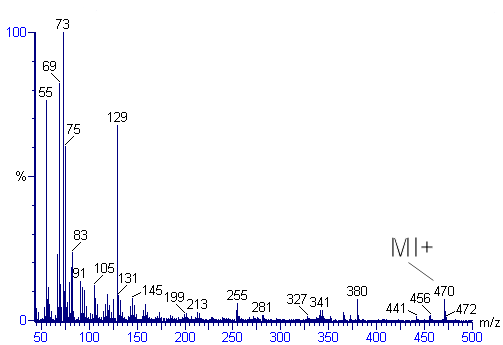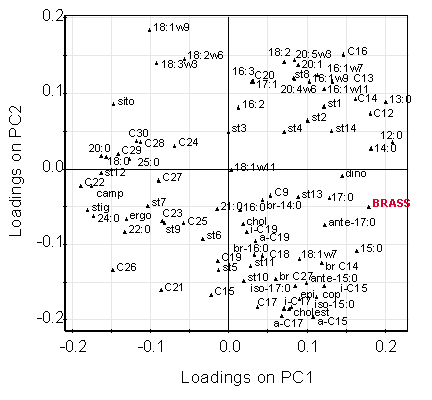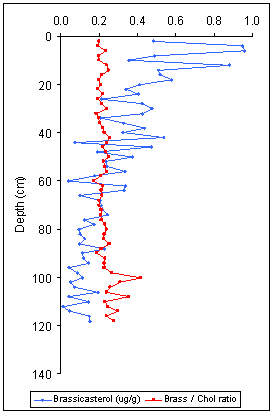Brassicasterol: Difference between revisions
Updating {{chembox}} (changes to verified and watched fields) per Chem/infobox_drug validation (report errors or bugs) |
Added refimprove tags- article seems accurate but is insufficiently cited |
||
| Line 1: | Line 1: | ||
{{Refimprove|date=June 2018}} |
|||
{{chembox |
{{chembox |
||
| Verifiedfields = changed |
| Verifiedfields = changed |
||
| Line 61: | Line 62: | ||
===Chemical analysis=== |
===Chemical analysis=== |
||
Since the [[molecule]] has a [[hydroxyl]] (-OH) group, it is frequently bound to other [[lipids]] including [[glycerol]]s; most analytical methods, therefore, utilise a strong [[alkali]] (KOH or NaOH) to [[saponify]] the [[ester]] linkages. Typical extraction [[solvents]] include 6% KOH in [[methanol]]. The free [[sterols]] are then separated from the [[polar lipids]] by partitioning into a less polar solvent (''e.g'', [[hexane]]). Prior to analysis, the hydroxyl group is frequently derivatised with [[BSTFA]] (bis-trimethyl silyl trifluoroacetamide) to replace the hydrogen with the less exchangeable [[trimethylsilyl]] (TMS) group. Instrumental analysis is frequently conducted on [[gas chromatograph]] (GC) with either a [[flame ionisation detector]] (FID) or [[mass spectrometer]] (MS). The [[mass spectrum]] for the TMS ether of brassicasterol can be seen in the figure.<br /> |
Since the [[molecule]] has a [[hydroxyl]] (-OH) group, it is frequently bound to other [[lipids]] including [[glycerol]]s; most analytical methods, therefore, utilise a strong [[alkali]] (KOH or NaOH) to [[saponify]] the [[ester]] linkages. Typical extraction [[solvents]] include 6% KOH in [[methanol]]. The free [[sterols]] are then separated from the [[polar lipids]] by partitioning into a less polar solvent (''e.g'', [[hexane]]). Prior to analysis, the hydroxyl group is frequently derivatised with [[BSTFA]] (bis-trimethyl silyl trifluoroacetamide) to replace the hydrogen with the less exchangeable [[trimethylsilyl]] (TMS) group. Instrumental analysis is frequently conducted on [[gas chromatograph]] (GC) with either a [[flame ionisation detector]] (FID) or [[mass spectrometer]] (MS). The [[mass spectrum]] for the TMS ether of brassicasterol can be seen in the figure.<br /> |
||
[[Image:mass spectrum brassicasterol.png|Mass fragmentation pattern for brassicasterol at 70eV on a Fisons MD800 mass spectrometer]] |
[[Image:mass spectrum brassicasterol.png|Mass fragmentation pattern for brassicasterol at 70eV on a Fisons MD800 mass spectrometer]]{{citation needed}} |
||
== Formation and occurrences == |
== Formation and occurrences == |
||
Revision as of 16:19, 18 June 2018
This article needs additional citations for verification. (June 2018) |

| |

| |
| Names | |
|---|---|
| IUPAC name
24-methyl cholest-5,22-dien-3β-ol
| |
| Other names
brassicasterol
(3β,22E)-ergosta-5,22-dien-3-ol 24β-methylcholesta-5,22-dien-3 beta-ol ergosta-5,22-dien-3β-ol | |
| Identifiers | |
3D model (JSmol)
|
|
| ChemSpider | |
| ECHA InfoCard | 100.006.807 |
PubChem CID
|
|
| UNII | |
CompTox Dashboard (EPA)
|
|
| |
| |
| Properties | |
| C28H46O | |
| Molar mass | 398.675 g·mol−1 |
| Appearance | White solid |
| Melting point | 150 to 151 °C (302 to 304 °F; 423 to 424 K) |
| Hazards | |
| Flash point | Non-flammable |
| Related compounds | |
Related Sterols
|
cholesterol β-sitosterol campesterol stigmasterol |
Except where otherwise noted, data are given for materials in their standard state (at 25 °C [77 °F], 100 kPa).
| |
Brassicasterol (24-methyl cholest-5,22-dien-3β-ol) is a 28-carbon sterol synthesised by several unicellular algae (phytoplankton) and some terrestrial plants, e.g., oilseed rape. This compound has frequently been used as a biomarker for the presence of (marine) algal matter in the environment.
Chemical properties
Solubility
Brassicasterol has a low water solubility and, as a consequence, a high octanol – water partition coefficient. This means that, in most environmental systems, brassicasterol will be associated with the solid phase.
Degradation
In anaerobic sediments and soils, brassicasterol is stable for many hundreds of years, enabling it to be used as an indicator of past algal production (see below).
Chemical analysis
Since the molecule has a hydroxyl (-OH) group, it is frequently bound to other lipids including glycerols; most analytical methods, therefore, utilise a strong alkali (KOH or NaOH) to saponify the ester linkages. Typical extraction solvents include 6% KOH in methanol. The free sterols are then separated from the polar lipids by partitioning into a less polar solvent (e.g, hexane). Prior to analysis, the hydroxyl group is frequently derivatised with BSTFA (bis-trimethyl silyl trifluoroacetamide) to replace the hydrogen with the less exchangeable trimethylsilyl (TMS) group. Instrumental analysis is frequently conducted on gas chromatograph (GC) with either a flame ionisation detector (FID) or mass spectrometer (MS). The mass spectrum for the TMS ether of brassicasterol can be seen in the figure.
 [citation needed]
[citation needed]
Formation and occurrences
It can be found in Mirabilis jalapa.[1]
Algal sources
Brassicasterol is formed in plants from the isoprenoid squalene through campesterol as an intermediate. A list of the algae in which brassicasterol has been identified is shown below together with approximate composition.[2]
| Species | A | B | C | D | E | F | G | H | others |
|---|---|---|---|---|---|---|---|---|---|
| Gonyaulax spp | 100 | 0 | 0 | 0 | 0 | 0 | 0 | 0 | 0 |
| Peridinium foliaceum | 100 | 0 | 0 | 0 | 0 | 0 | 0 | 0 | 0 |
| Peridinium foliaceum | 80 | 20 | 0 | 0 | 0 | 0 | 0 | 0 | 0 |
| Gonyaulax diegensis | 39 | 0 | 0 | 0 | 0 | 0 | 0 | 29 | 32 |
| Pyrocystis lunula | 76 | 6 | 0 | 2 | 1 | 0 | 0 | 0 | 15 |
| Gonyaulax polygramma | 36 | 1 | 0 | 9 | 7 | 0 | 0 | 0 | 47 |
| Gymnodinium wilczeki | 26 | 39 | 0 | 35 | 1 | 0 | 0 | 0 | 0 |
| Glenodinium hallii | 8 | 50 | 0 | 0 | 0 | 42 | 0 | 0 | 0 |
| Noctiluca milaris | 0 | 1 | 1 | 5 | 73 | 0 | 6 | 0 | 14 |
| Gymnodinium simplex | 0 | 0 | 0 | 0 | 53 | 0 | 0 | 0 | 47 |
| Prorocentrum cordatum | 7 | 0 | 0 | 0 | 5 | 0 | 63 | 0 | 25 |
- A = cholesterol
- B = campesterol
- C = sitosterol
- D = 22-dehydrocholesterol ((22E)-cholesta-5,22-dien-3β-ol)
- E = brassicasterol
- F = stigmasterol
- G = 24-methylene cholesterol
- H = fucosterol
Use as a tracer for marine algae
The principal source of brassicasterol in the environment is from marine algae. Its relatively high concentration and stability allows it to be used in the assessment of the origin of organic matter in samples, especially sediments.
Brassicasterol / cholesterol ratio
The concentration of brassicasterol in a core sample from Loch Striven, Scotland. Highest values may be seen in the top sections of the sediment, which decrease with depth. However, the cholesterol behaves in a similar manner, and the ratio brassicasterol/cholesterol is fairly uniform at all depths, indicating either a comparable degradation rate with no change in source or different degradation rates and a change in source.
Multivariate analysis
Multivariate statistical analyses such as principal component analysis of a range of lipid biomarkers (e.g., other sterols, fatty acids, and fatty alcohols) enable identification of compounds that have similar origins or behaviour. An example can be seen in the loadings plot for sediment samples from the Mawddach Estuary, Wales.

The location of brassicasterol in this figure (shown in red) indicates that the distribution of this compound is similar to that of the short-chain fatty acids and alcohols, which are known to be of marine origin. The terrestrially derived biomarkers such as β-sitosterol are on the opposite side of the figure and are mutually exclusive.
References
- ^ Constituents of Mirabilis jalapa. Siddiqui S., Siddiqui B.S., Adil Q. and Begum S., Fitoterapia, 1990, Volume 61, No. 5, page 471 (abstract)
- ^ Data from a review by Volkman, 1986[clarification needed]

